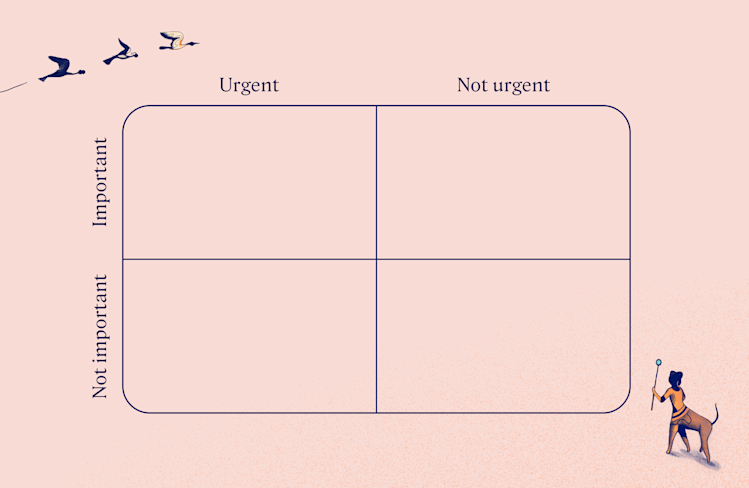5 Science-Backed Tips to Maintain Your Productivity When Working Remotely
Working from home? Your productivity doesn’t have to suffer. Here are five science-backed tips to boost your focus and get more done.
You’re working from home with the best intentions for dominating your to-do list.
You answer a few emails before getting distracted and scrolling through wedding photos of somebody you barely know on social media. You unload the dishwasher. You have a quick team meeting. You brush your dog, check off a few more to-dos, and walk to your mailbox.
Next thing you know, it’s already 4pm and over half of the items on your task list remain incomplete. What gives?

Working from home has been proven to boost productivity, but that’s only the case if you know how to do it effectively. Yet, remote work has its own unique set of challenges – like the fact that distractions (and your couch) are always lurking around the corner.
5 tips to amp up your work-from-home productivity
If you’re eager to figure out how to be productive at home, you’re probably already familiar with oft-repeated advice like creating a schedule or ditching your pajamas and getting dressed for the day. Those tips definitely have their merit.
But, if you really want to tune out time-wasters, focus on your tasks, and boost your efficiency, there are a few other science- and psychology-backed tips that can help you kick your output up another notch (even if you decide to stick with your pjs).
1. Schedule break times
Think you can unlock remote productivity by working more hours? Not quite. As counterintuitive as it seems, frequent breaks help us work even more effectively. Our brains weren’t built for prolonged focus. So, when you find yourself getting distracted, it’s more than likely your brain is begging for some reprieve.
It’s important that you’re intentional about how and when you take those breathers, and a time management system can help you do that. A few techniques people swear by include:
Pomodoro technique: You work in 25-minute intervals with five-minute breaks in between. Once you complete four cycles, take a longer break of 15-30 minutes.
52/17 rule: There isn’t a catchy name for this one, but research has shown that working for 52 minutes and then taking a 17-minute break is an ideal schedule.
Time blocking: You split your schedule into chunks of time dedicated to specific tasks.
And remember, not all breaks are created equal. To make the most of that quick time off, resist the urge to spend it perusing the internet.
Instead, give yourself some actual space by stepping away from your computer. Go for a quick walk, grab a snack, stretch your sore muscles, or simply sit on your couch and do nothing. That will refresh your brain way more than aimless scrolling.
2. Create a suitable working environment
Are you still working from a rickety TV tray in your living room? Or a backless bar stool at your kitchen counter? It’s time to craft an environment that’s more conducive to productivity. Trust us – your brain and your lower back will thank you.
Studies show that our physical work environment has a huge impact on our performance, so it’s worth investing a little energy (and maybe even a little money) into setting up a space where you can thrive.
An “ideal” work environment can look different for everyone. But, here are a few tips to get you started:
Pay attention to ergonomics: The right equipment like a supportive desk chair or lumbar pillow, a wrist rest, or even blue light blocking glasses can help you get your work done without aches and pains.
Add a desk plant: Believe it or not, adding a plant to your desk or workspace can actually help you get more done. Research shows that plants can increase productivity by as much as 15%.
Incorporate a few personal elements: Whether it’s some artwork from your kiddos or a photo from your favorite vacation, add a few items that make you happy. You spend a lot of time at your desk, so make it a place where you feel comfortable and inspired.
Crafting a suitable work environment is important, but that doesn’t mean you need to be stuck there all day every day. Changing up your surroundings every now and then – like moving to your patio, balcony, or even your kitchen table for an hour – gives your brain the novelty it craves and keeps you sharp.
3. Set some ground rules with your team
When you’re working from home, you don’t have colleagues dropping by your desk unannounced and you no longer have to rip your attention away from a project to partake in a birthday celebration (and another slice of cake) in the common area.
But that doesn’t mean you’re left to work in total peace and quiet. Not even close. You’ll likely be so inundated with emails, meeting invites, and instant message pings that you hear those knocks and buzzes in your dreams.
It’s exhausting, and it goes a long way in explaining why 49% of employees in one survey said they'd rather clean their bathroom than work through 10 days of unopened emails. Yikes.
The good news is that you can manage and minimize these digital distractions by setting clear and shared communication ground rules with your team. A few ideas include:
Picking days or times that are designated as meeting-free and reserved for deep work.
Coming up with a status or symbol that indicates you shouldn’t be interrupted (for example, the brain 🧠 next to your name in Slack can mean you’re in focus mode right now).
There isn’t one system that’s best for every team, and some trial and error can help you find the right strategies for you. The important thing is to try. When an estimated 80% of our work time is spent communicating, any tactics that help minimize unnecessary or untimely pings and prods are helpful.
4. Pick your top tasks (and then stop multitasking)
Here’s a scary stat: 41% of to-do list items are never completed. Before you write yourself off as a slacker, consider this: What if our to-do lists are unmanageable in the first place?
That’s often the case – we all have the tendency to overwhelm ourselves with lengthy and ever-growing task lists, and it makes it challenging to turn down the noise and get clarity about what actually needs to be done today.
An Eisenhower Matrix (also known as a Priority Matrix) is an easy visual tool you can use to get focused on your pressing items. It’s simple: draw a square and then split it into four even quadrants.
Over the top squares, write “Urgent” and “Not Urgent.” Down the left side, write “Important” and “Not Important.” Now, categorize your tasks accordingly. For example, finishing your presentation is both urgent and important, so it goes in the top left box.

Once you have everything categorized, you can decide how to act on each item. Here are the typical rules:
Urgent and important: Do these tasks first.
Urgent and not important: Delegate to others if you can.
Not urgent and important: Schedule time to work on these later.
Not urgent and not important: Remove them from your list entirely.
When you’re equipped with your most pressing priorities for the day, focus on one at a time. Multitasking is a myth for most of us. You aren’t actually doing more than one thing at once – you’re quickly switching between tasks, and that rapid changing of gears is detrimental to your productivity.
5. Make the most of your remote meetings
We’ve all heard the endless gripes about meetings, especially ones that happen remotely. In fact, 49% of professionals say they have a high degree of exhaustion as a result of too many daily video calls (a phenomenon coined as “Zoom fatigue”).
What’s more, bad meetings don’t just destroy our productivity in the heat of the moment. We can also experience “meeting recovery syndrome,” where we lose even more working time as we mentally bounce back from a meeting that felt like a colossal waste of time.
Here’s the thing, though: Meetings aren’t inherently bad on their own. When they’re done well, they provide an outlet for brainstorming, problem solving, collaboration, and feedback. So, if you want to boost productivity and avoid groans, gripes, and eye rolls about your remote meetings, make sure you:
Have a clear goal for the meeting and an agenda that you share ahead of time
Invite the right attendees – meaning, everybody should have a clear purpose for being there
Frequently evaluate your recurring meetings to make sure they aren’t glorified catch-up sessions or time wasters
Use easy and intuitive virtual meeting technology (like Whereby) to avoid glitches and frustrations
Making the most of your virtual meetings means you not only spend less time on pointless ones, but also that you walk away from each conversation with clear decisions and action items. Ready for better meetings? Get started with Whereby for free today.
You can get just as much (if not more) done while working from home
Remote work offers plenty of productivity-boosting advantages—like skipping a commute and not getting distracted by your colleague’s phone conversations at the next desk.
However, it also comes with some unique challenges that can sidetrack your ambition and sabotage your focus.
Like anything else, figuring out how to be productive when working from home is a learning experience. But, commit to the process and you’re bound to find the right strategies that help you end the day feeling impressed and fulfilled—rather than frazzled and frustrated.


